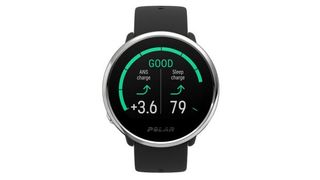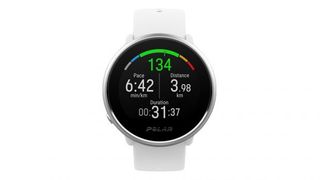Our Verdict
The Polar Ignite is the most surprising and exciting new tracker of 2019. Polar has crammed in an impressive array of features – including some entirely novel ones that can guide your entire training regime – into a good-looking watch that has a gorgeous touchscreen. There are some flaws, and keen runners and those who want smart features like music are better served elsewhere, but the Ignite is the best all-round fitness watch for under £200.
For
- Nightly Recharge features
- Daily workout suggestions
- Slim, lightweight and stylish design
Against
- Sleep tracking not always accurate
- GPS accuracy
- Battery life
You can trust Coach

Polar Ignite

Polar Ignite
Watch face

Polar Ignite
FitSpark cardio training recommendation

Polar Ignite
Nightly Recharge measurement

Polar Ignite
Sleep charge

Polar Ignite
Autonomic nervous system score

Polar Ignite
Serene guided breathing

Polar Ignite
Run tracking

Polar Ignite
Indoor training tracking
Should I Consider Buying Something Else?
If you’re looking around at the best fitness trackers and are a runner first and foremost then there are better options than the Ignite, with the Garmin Forerunner 45 being the obvious pick. It’s cheaper than the Ignite, it’s easier to use and it has better battery life and GPS accuracy too. The Ignite is also lacking in smart features like music storage, so if that’s important to you the Fitbit Versa 2 might be more up your alley, even if the Versa is far less capable as a sports watch.
However, there is nothing else quite like the Ignite available, especially in the sub-£200 bracket, with features like the daily workout suggestions and in-depth recovery tracking putting it in a league of its own. Furthermore, it’s a proper GPS multisport watch for under £200, which isn’t all that common. The Coros Pace (£179.99) is a great multisport watch with a better battery life and it’s easier to use than the Ignite, but the Ignite’s excellent recovery features and the depth of detail you get on your training through the Polar Flow website and app mean it far outstrips what Coros offers.
The Polar Ignite In-Depth
Sleep Tracking With The Polar Ignite
Sleep tracking is all too often an afterthought in the world of serious sports trackers. Garmin has made some effort on this front but the analysis is undermined by inaccurate data, while Suunto and Coros offer only a basic outline of your night’s rest. Polar, in contrast, has gone all-in on sleep tracking, particularly with regard to how it affects your recovery and ability to train the next day.
Each morning the Nightly Recharge feature tells you how well you’ve recovered overnight, which is based on your sleep and the activity of your autonomic nervous system (the bodily functions you don’t have to be conscious of, like breathing). The latter is measured through your heart rate, heart rate variability and breathing rate while asleep. You want your heart rate variability to be high while asleep because this shows your body is not under stress and so is recovering.

The quality of your sleep is measured through six factors in three categories: amount, solidity and regeneration. In the Polar Flow app the results are engagingly presented with a colour-coded six-pointed star, and you also get a graph of your night’s sleep showing the time spent in light, deep and REM sleep, along with any interruptions, plus a sleep score out of 100 if you can’t be bothered to dive into all the detail.
Polar takes this info and then recommends what exercise you should do the next day based on how well your system has recovered, recommending four workouts you could try.
It all sounds great and at first I was impressed by the depth of info the Ignite seemed to be providing on my sleep – and indeed what it was doing with that info, particularly the recommendations regarding how active I should be the next day. However, after a few weeks with the Ignite the features started to show a few cracks.
For one, the sleep tracking wasn’t always that accurate, often missing the time I actually went to sleep by several hours. Across a month of wearing the device it logged the start of my sleep as two or three hours after I actually fell asleep about a third of the time. I have a baby, so I’m acutely aware of my sleep and I’m going to bed very early, which means a sleep start time of 1am stands out as clearly wrong.
Then there’s the fact that whatever my Nightly Recharge was rated as, the Ignite told me I was good to go when it came to exercise the next day. I’ve been told my recharge was “excellent”, “okay”, the slightly alarming “compromised” or “poor”, and the recommendation was always that it was a good day for training. I sometimes got a qualifying message along the lines of “you might be tired”, but this was always followed with advice to exercise anyway. The recommended workouts from the watch might change to something more strength-based rather than a long cardio session, or say to take that cardio session easy, but when my recovery was rated poor I was surprised to still see I was recommended a 67-minute cardio session.
I’ve always thought that sports watches that recommend recovery times after workouts and gauge your overall training load should take into account sleep, so I’m pleased Polar is taking steps to do this with the Nightly Recharge feature, but it’s not perfect yet. It’s interesting to get an instant rating on your wrist of how your sleep has recharged you when you wake up, but if the tracking isn’t flawlessly accurate (or at least better than broadly right two-thirds of the time) and the recommendation is always to exercise anyway, it loses some of its appeal.
However, it’s very close to being really smart, and I have noticed the accuracy of the sleep tracking is trending upwards in the time I’ve had the Ignite. Polar is certainly on to something here – you can use the Ignite to shape all your training based on the state of your body that day, which will help you avoid injury and actually enjoy your training because you’re working at the right level for your energy levels. It just needs to iron out some small wrinkles.
Sports Tracking With The Polar Ignite
One of the areas where the Ignite stands out from the competition is the vast range of sports modes it offers, including a dedicated multisport mode for triathletes, duathletes and anyone else who likes to do more than one sport in one session, as well as an open-water swimming mode. This is something Garmin does not offer on its cheaper watches like the Forerunner 45 and 245, which are aimed squarely at runners.
Even more exciting is that the Ignite doesn’t just passively track all these sports, it directly recommends what you should do via the FitSpark feature. Each day you’ll be recommended four workouts across three categories – Cardio, Strength and Supportive, with the latter being activities like stretching and fundamental core exercises.
What you’re told to do is based on the Nightly Recharge estimate of how well recovered you are each day, so in theory you’ll never be told to do something that’s beyond your energy levels that day.
Choose a Cardio workout and you can do the session while running, cycling, swimming or doing anything else that gets your heart rate up, with the guided session based entirely on your heart rate (the Ignite will record this while swimming, though accuracy can be hit and miss in the water).
For the Strength and Supportive sessions you can see the exercises you’ll be doing on the watch before starting, and once you get going it will guide you through your circuits. Experienced gym-goers aiming to add serious muscle might not get much from the strength sessions, which mostly involve bodyweight exercises, but they’re the perfect way for most people to increase their full-body strength and particularly useful for runners, triathletes and team sport types who need a quick and easy-to-follow session to support their main activity.
Once you’ve done a Cardio or Strength session each day the Ignite will change its recommended workouts to a Supportive session so, for example, you can add some stretching at the end of a run.
Although I didn’t see a huge change in the workouts based on my Nightly Recharge readings, I was still impressed by the FitSpark feature. If you’re following your own training plan already you can use the odd session here or there to support it, but if you just want to get fit and don’t really know what to do, you can simply use the Ignite’s suggestions each day, or every other day, to get seriously fit.
Running With The Polar Ignite
Aside from measuring running power from your wrist and offering breadcrumb navigation (which are both restricted to the high-end Vantage V), Polar hasn’t held back any run tracking features from the Ignite. You can set up to four stats per screen and follow guided workouts or even training plans from your wrist, with Polar’s plans especially good for anyone who wants to train using their heart rate.

I was also delighted to see that you can set the screen to be always-on during a run, or indeed any workout. This is something you can’t do on the Apple Watch, which makes it hard to see your stats at a glance.
Opting for always-on will hit your battery life hard, but I’d rather charge a watch every day or every other day and significantly increase how easy it is to use during a workout, and Polar’s decision to give users the choice is welcome. That said, you do have to switch it to always-on in every individual workout – there’s no master setting that makes that the default option.
One considerable problem with the design of the Ignite for runners is that there is no lap button. You have to rely on auto-lap and if you’re doing a guided workout where you want to manually start each section, you have to do so by pressing a button on the touchscreen. The Ignite’s touchscreen is not 100% reliable in registering a touch at the best of times, and when you’re trying to hit a fairly small section of it with sweaty fingers while running hard it’s more like 50% reliable, which can be frustrating. My advice is to stick to workouts where it automatically moves on to the next section.
The other significant problem with the run tracking is that, as with the Vantage V and Vantage M trackers, I’ve consistently found the GPS readings on the Ignite to be off. They come in short of the actual distance on most runs, with the disparity growing when I did a run with a lot of sharp bends – it produced 9.6km for a 10K race with six hairpin bends in it, for example. Polar seemed to have worked on this since the Vantage was released and the distance tracking across its range is getting more accurate, but it’s still not infallible.

I was more impressed with the heart rate tracking accuracy of the Ignite, however. On a couple of runs it locked on to my cadence to begin with before finding my heart rate a couple of kilometres in, but generally it was pretty close to bang on from the start and then throughout my runs, even when I was doing intervals – with the Ignite keeping pace with the rapid changes in heart rate.
The Ignite links to the Polar Flow app and website, which provides a lot of detail on your training. Too much for the average runner, in truth, and it can be confusing to navigate. However, there are some key areas which are worth checking out. The best of these is Training Load Pro, which analyses your recent training to see if you’re being productive in improving your fitness, overdoing it, maintaining your fitness or undertraining. This information is plotted over time along with your cardio load report, which shows the strain you’re putting on your system along with your tolerance.
Both are useful estimates of whether your workload is suitable for you, which can help you avoid injury. In theory, with the Ignite on your wrist you can ignore all this and just go by its suggestions each day, but it’s there if you do want to dive into more detail or are following your own training plan ahead of a big event.
Activity Tracking With The Polar Ignite
The Ignite tracks your daily steps, calories burned and active minutes, and puts those all together along with your exercise to create an overall daily activity goal. This includes a choice of three levels that you set in your profile and can change at any time.
Broadly speaking, the levels roughly break down as level one for mostly sedentary people aiming to get a little more active, with the goal being something like hitting 10,000 steps a day. Level two is for people who train several times a week and level three is for extremely dedicated people, training almost every day, who are also active outside their training. As an example of the standards expected for level three, on a day where I ran 14km and logged over 15,000 steps in total, I just squeaked to 104% of the target.
Once you’ve set your target you can view your progress on the Ignite or in the Polar Flow app. which provides an attractive colour-coded ring of your day so you can see periods when you were more active, along with any inactivity stamps you’ve earned by staying still for too long.
In my opinion Polar’s activity target is a little more engaging than a simple steps count and does a good job of motivating you to stay active in between your training sessions, which can be a common failing among even very active people.
How Often Am I Going To Have To Charge It?
This depends on whether you set the screen to always-on during activities. If you do, you’ll see the battery drain at around 20% an hour, assuming you’re doing an activity that also uses the GPS. If you keep the screen off until you look at it – which is far less convenient especially when running or cycling outside, when you don’t want to stare at your watch for a second longer than necessary – and train every other day, you might get three days of battery out of the Ignite.
If you do have the screen on and/or train most days you’ll need to charge the Ignite every other day at least. And since its sleep tracking features are a key part of its appeal, you’ll need to do that during the day. Fortunately the Ignite charges quickly – I found that plugging it in for 60 minutes or so in the evening just before bed was enough.
Where Can I Wear It Without People Laughing At Me?
The Ignite is the most aesthetically pleasing device Polar has produced – for me it’s far better-looking than the pricier Vantage series. The slim watch and silver bezel won’t look out of place anywhere, but you might have to opt for the black band if you want it to work across different outfits and situations – the white and yellow bands are a little more ostentatious.

Nick Harris-Fry is a journalist who has been covering health and fitness since 2015. Nick is an avid runner, covering 70-110km a week, which gives him ample opportunity to test a wide range of running shoes and running gear. He is also the chief tester for fitness trackers and running watches, treadmills and exercise bikes, and workout headphones.
